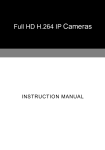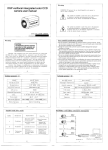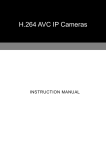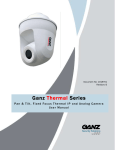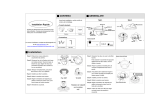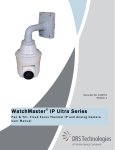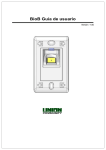Download "user manual"
Transcript
AiP 960H Series Speed Dome Camera INSTRUCTION MANUAL Executive Summary H.264 D1 video server or AiP camera uses the latest compression technologies providing 4-Streaming of H.264 and JPEG in different resolutions. 4-Streaming technologies allow transmitting digital video at various bitrate and frame rate to fit both high and low bandwidth network environment. Built-in intelligent video analytics engine enables audio and motion detection for extra protection. These features can be easily interfaced by other applications. Other useful features include two-way audio, SD card recording (video server), smartphone live access, email snapshot, and continuous sending JPEG snapshots to an FTP server. H.264 Video Server and D1 AiP camera have the latest technologies video de-interlace, built-in video analytics, and ONVIF conformant with all these features integrated within one camera. AIM Software system solution with H.264 D1 video server or AiP camera series can provide integrated system solution in migrating to IP Video application. Key Features H.264 D1 video server or AiP camera at 30 FPS Support dual encoding format H.264 and JPEG 4-Streaming technology, 4 concurrent streaming available Smartphone live monitoring Built-in intelligent video analytics(IVA) engine for audio and motion detection IVA alarm notification via Email or FTP Two-way audio (for audio models only) Bit rate and frame rate adjustable on-the-fly Support Android, iPad, and iPhone mobile live monitoring DDNS and UPnP supported Network time protocol (NTP) supported Support PCM/G.711 audio streaming Support ONVIF protocol Support AIM Software HD 2.6 Trademark Acknowledgments Microsoft, Windows 2000, Windows XP, Windows Vista, Windows 7, ActiveX, and Internet Explorer are registered trademarks of Microsoft Corporation in the U.S. and/or other countries. Java and all Java-based trademarks and logos are trademarks or registered trademarks of Sun Microsystems, Inc. in the United States and other countries. 1 Flash, Macromedia, and Macromedia Flash Player are either trademarks or registered trademarks of Adobe Systems Incorporated in the United States and/or other countries. Linux and DynDNS are registered trademarks of the respective holders. Intel, Pentium, and Intel® Core™ 2 Duo are registered trademarks of Intel Corporation. FFmpeg is a trademark of Fabrice Bellard, originator of the FFmpeg project. QuickTime and the QuickTime logo are trademarks or registered trademarks of Apple Computer, Inc., used under license there from. Other names of companies and their products mentioned in this manual may be trademarks or registered trademarks of their respective owners. Other References Smartphone For smartphone live monitoring, please visit appendix for the details. AI Universal ActiveX Control Sample code and document are included in product CD and can be downloaded from our company website. AI HTTP API For non-ONVIF integration, please see AI HTTP API document. We adopt HTTP API document for all AI AiP cameras. Caution Do not drop or strike this equipment Do not install the equipment near any naked flames or heat sources Do not expose this unit to rain, moisture, smoke or dust environment Do not cover the opening of the cabinet with cloth and plastic or to install this unit in poor ventilated places. Allow 10cm between this unit and its surroundings Do not continue to operate the unit under abnormal conditions such as detection of smoke, strange smell or no display on screen while power is turned on Do not touch the power connection with wet hands Do not damage the power cord or leave it under pressure Do not operate this unit near magnet, speaker system, etc., to avoid unnecessary magnetic interference Connection cables should be grounded properly 2 Table of Content Chapter 1 System Overview .................................................................................... 5 Chapter 2 Before Accessing AiP camera................................................................. 6 Chapter 2-1 Configure IP Address Using IPScan Utility ..................................... 6 Chapter 2-2 Configure IP Address Using HTML Page ....................................... 7 Chapter 2-3 Internet Browser Setting & Software Component Required ........... 7 Chapter 2-4 Login ............................................................................................... 7 Chapter 3 Start Using the Camera ........................................................................... 9 Chapter 3-1 AiP camera Operational HTML Page ............................................. 9 Chapter 3-2 PTZ Control Panel .......................................................................... 9 Chapter 3-2-1 PT Mode ............................................................................... 10 Chapter 3-2-2 ePTZ ..................................................................................... 11 Chapter 3-2-3 Camera Control Panel .......................................................... 12 Chapter 3-2-4 Two-way Audio ..................................................................... 12 Chapter 3-2-5 Record in a Local PC ............................................................ 12 Chapter 3-3 Configurations ............................................................................... 13 Chapter 3-3-1 Server Settings ..................................................................... 13 Chapter 3-3-2 User Settings ........................................................................ 13 Chapter 3-3-3 Timer ..................................................................................... 14 Chapter 3-3-4 System Setting ...................................................................... 15 Chapter 3-4 Network ......................................................................................... 15 Chapter 3-4-1 General Settings ................................................................... 15 Chapter 3-4-2 DHCP Setting ....................................................................... 16 Chapter 3-4-3 HTTP & RTSP Service ......................................................... 16 Chapter 3-4-4 SMTP Service ....................................................................... 17 Chapter 3-4-5 FTP Service .......................................................................... 17 Chapter 3-4-6 DDNS Settings ...................................................................... 18 Chapter 3-4-7 UPnP Settings ...................................................................... 18 Chapter 3-5 Video Settings ............................................................................... 19 Chapter 3-5-1 Video General ....................................................................... 19 3 Chapter 3-5-2 Weighted Streaming Mode ................................................... 20 Chapter 3-5-3 Chapter 3-6 Video Quality ........................................................................ 21 PTZ Settings ................................................................................. 21 Chapter 3-6-1 PTZ Advanced Settings ........................................................ 21 Chapter 3-6-2 PTZ Schedule Settings ......................................................... 22 Chapter 3-7 SD Card Recording ....................................................................... 23 Chapter 3-7-1 Chapter 3-8 SD Card Recording Setting .................................................. 23 Alarm Settings ............................................................................... 24 Chapter 3-8-1 Motion/Alarm Setup .............................................................. 24 Chapter 3-8-2 Alarm (DI) Input Detection .................................................... 24 Chapter 3-8-3 Motion Area .......................................................................... 25 Chapter 3-8-4 Audio Detection .................................................................... 25 Chapter 3-9 Audio Setting................................................................................. 26 Appendix ................................................................................................................... 27 Advance Network DDNS and PPPoE Technologies ........................................... 27 Advance Network Port Forwarding Technology .................................................. 27 iPhone Access ..................................................................................................... 28 Android Access .................................................................................................... 28 Emergency Factory Default ................................................................................. 29 SD Card Compatibility List ................................................................................... 30 Specification ............................................................................................................. 31 4 Chapter 1 System Overview Chapter 1-1 System Requirements The AiP camera’s H.264 video compression technology can provide high compression rate and superior video quality. However, the performance highly depends on both CPU computational power of a client PC and the network bandwidth for transmitting video streaming. The following sections specify system requirement for running the H.264 AiP camera: Chapter 1-2 Software Requirements AI Universal ActiveX software components are required for web interface for displaying JPEG or H.264 video. When you first time login the AiP camera using Internet Explorer, it prompts for a security warning dialog box for downloading AI Universal ActiveX. Please click on Install button to download. Flash player is also required for controlling the PTZ device. Please visit http://www.adobe.com/products/flashplayer to download the software component. 5 Chapter 2 Before Accessing AiP camera Before accessing to the AiP camera, make sure that the camera’s RJ-45 network cable, audio cable, and AiP camera’s power cable are properly installed. For setup IP address, please consult your network administrator for available IP addresses. The default IP address of AiP camera is 192.168.0.200. User can also use default IP address to verify AiP camera’s network connection. Chapter 2-1 Configure IP Address Using IPScan Utility To configure IP address using IPScan utility, copy IPScan application from installation CD to your local PC or execute IPScan software from installation CD directly. IPScan utility can also be downloaded from our company website. To change IP address, subnet mask, gateway, or HTTP port, please follow steps below: Run IPScan utility. Click on Refresh button. All available devices get listed in Device list box. Select the device item in Device list box. Edit or modify addresses in IP, Subnet Mask, Gateway, or HTTP Port edit box. Click on Apply button to configure the settings. Click on Refresh button to verify the settings. Note: Make sure that IPScan is version 1.0.0.31 or above. 6 Chapter 2-2 Configure IP Address Using HTML Page To change IP address using HTML page, please first type the default IP address, 192.168.0.200, in Internet browser and follow steps below: Logon H.264 D1 video server or AiP camera using default username and password—“admin” and “pass”. Click on “Configure” hyper link. Click on “Network->General” hyper link. Type or modify edit box for IP address, subnet mask, gateway, or HTTP connection port. Click on Submit button. Chapter 2-3 Internet Browser Setting & Software Component Required Make sure that your Internet Browser allows signed ActiveX plug-in running on your PC. Set “Download Signed ActiveX plug-in controls” to “Prompt” and “Run ActiveX control and plug-in” to “Enable” at Internet Explorer->Tools->Options->Security Settings. After finishing above security settings, accessing H.264 D1 video server or AiP camera’s live video by default IP address of H.264 D1 video server or AiP camera using Internet Explorer will prompt a Security Warning dialog box. Click on OK button to download the ActiveX directly from H.264 D1 video server or AiP camera. Chapter 2-4 Login There are two levels of user authentication including administrator and guest for accessing the H.264 D1 video server or AiP camera. 7 The default settings of username and password are described as follows: Administrator Guest Username admin guest Password pass guest To logon the H.264 D1 video server or AiP camera, please type username and password in logon HTML page and click on Submit button to enter the system. 8 Chapter 3 Start Using the Camera After login H.264 D1 video server or AiP camera as administrator, there are two main features—system operation and configuration. Operation and configuration features are described as follows: Chapter 3-1 AiP camera Operational HTML Page Operational HTML page layout 3 4 1 5 2 1. 2. 3. 4. 5. Camera Control panel — AiP camera control panel. AI Universal ActiveX control — Display RTSP H.264 or JPEG network video. Profile switching menu — Switching one profile to another Setup menu — AiP camera setup menu PTZ control panel Chapter 3-2 PTZ Control Panel All the PTZ features are described as follows: Iris +: Iris large Iris –: Iris small 9 Auto Iris: Set the device to auto Iris mode. Focus +: Focus far Focus -: Focus near Auto Focus: Set the device to auto focus mode. OSD Enter: Enter PTZ device’s internal setting. OSD Esc: Exit PTZ device’s internal setting. Wide: Lens zoom out Tele: Lens zoom in Preset: Preset points recall Note: Please read PTZ’s instruction manual for OSD setting. Chapter 3-2-1 PT Mode There are four Pan and Tilt Modes (PT) for users to operate the PTZ device. To select one of the PT modes, please click on the icon under PT Mode panel. PT mode PT mode with speed Lower speed (inner) Higher speed (outer) 10 Pan mode at absolute position Absolute position Pan and tilt modes at absolute position Absolute position Tilt lens Chapter 3-2-2 ePTZ To perform ActiveX ePTZ feature, please use a computer mouse to drag on the ActiveX control. AI Universal ActiveX control becomes eZoom mode. Please use computer mouse pointing to the sub-window of PIP view. Dragging the sub-window can perform ePan and eTilt. Using mouse scroll button can perform zoom in and out features. Performing right-mouse click on the video can disable ePTZ feature. 11 Chapter 3-2-3 Camera Control Panel Control panel buttons are described as below: Snapshot: Take a snapshot of the video. Recording at PC Speak on: Speak to remote site (for audio model only). Audio on: Set audio on (for audio model only). Activate alarm output (for alarm model only). Chapter 3-2-4 Two-way Audio For two-way audio, please click on Microphone icon for speaking to the remote site. To stop speaking to the remote site, please click on Microphone icon again. To listen to the remote site, please click on Speaker icon for listening to the remote site. To stop listening to the remote site, please click on Speaker icon again. Note: Only AiP camera models with audio can support this feature. Chapter 3-2-5 Record in a Local PC To record into a local PC, please first right-click on AI Universal ActiveX control. It shows up in the setting dialog box. A user can specify the recording path and recording size. Please make sure that the ePTZ or ROI feature is unchecked for displaying recording setting dialog box by right-mouse-click. To playback the AVI video, simply click on Windows Media Player. 12 Chapter 3-3 Configurations H.264 D1 Video Server or AiP camera’s administrator can configure the device via standard HTML web pages. This chapter explains the detail of each configuration setting. Chapter 3-3-1 Server Settings Server settings contain H.264 D1 video server or AiP camera server’s system information such as MAC address, firmware version, users, system timer, and other system settings. To change or to use these options, please follow the instructions at this section. Mac Address -- Network MAC address of the video server or camera Firmware Version & OS Version Firmware update allows a user to upgrade H.264 D1 video server or AiP camera’s firmware remotely. A user can use firmware version to verify if the device has the latest version. Device Name The device name can be used by IPScan utility to identify the H.264 D1 video server or AiP camera To change the device name, enter the name for H.264 D1 video server or AiP camera and click on Submit button. Language -- Language setting can be changed dynamically. OSD Name -- Display camera name. OSD Time -- Display camera timer. ActiveX OSD Name -- Display camera OSD name on only ActiveX. Chapter 3-3-2 User Settings There are ten user accounts allowed for the system. Each account can be configured for its access rights. To add/edit a user, please click on Add/Edit User button. To access H.264 D1 video server or AiP camera without authentication, set Bypass Logon 13 radio button to ON. To change account name, please type the new account name in Account edit box. To change new password, please type the new password in the New Password edit box. Click on Submit button to update the user settings. To delete a user, please click on “Remove User” button. Administrator: Enable or disable setup mode for a user. Camera Control Panel: Enable or disable Control Panel for a user. PTZ: Enable or disable PTZ feature for a user. Streaming: Enable or disable a streaming for a user. Chapter 3-3-3 Timer H.264 D1 video server or AiP camera allows a user to change system timer via standard HTML web page. To change H.264 D1 video server or AiP camera’s system timer, please enter the date and time in the edit boxes. Click on Submit button to apply this operation. Synchronize with NTP To synchronize Internet time system, check Auto Synchronize option to “Every Hour”. H.264 D1 video server or AiP camera synchronizes its system timer with a time server every hour. 14 Note: Network Time Protocol feature requires Internet connection. Synchronize with a PC A user can synchronize the PC system timer to the AiP camera's system timer. Chapter 3-3-4 System Setting Load Default feature allows to load manufacturing default. There are certain critical settings such as IP addresses and video system which are not affected by this operation. To reboot H.264 D1 video server or AiP camera, click on Reboot System hyper link. To update firmware of H.264 D1 video server or AiP camera, please click on Firmware Note: In case of forgetting the password, the device is required to send back to our company for a manufacturing default or read appendix for emergency default. Update hyper link. Locate “flasham.bin” in your computer by clicking the Browse button. Click Submit button to finish firmware upgrade. To ensure the quality of transmission, please make sure that there is no user accessing H.264 D1 video server or AiP camera during firmware upgrade. Chapter 3-4 Network H.264 D1 video server or AiP camera provides Internet protocols including IP, DHCP, and DDNS. A user can configure these Internet protocol settings. To setup above, please read the following sections: Chapter 3-4-1 General Settings Network general settings are the basic settings connecting H.264 D1 video server or AiP camera to the network. The default IP Address of H.264 D1 video server or AiP 15 camera is 192.168.0.200. A user can use this IP address to verify the network connection between a local PC and H.264 D1 video server or AiP camera using Web Browser. For local area network configuration, please enter, at least, IP address, Subnet Mask, and Gateway IP. Click Submit button to update these settings. For Internet access configuration, please contact your local ISP for global IP address. Once the physical Internet connection gets installed, enter IP address (global), Subnet Mask, and Gateway IP from the ISP. Default DNS IP Address — Primary Domain Name Server, the IP address of the domain name server Second DNS IP Address — Secondary Domain Name Server, the IP address of the domain name server, a backup DNS server for default DNS PPPoE Account — Account name of PPPoE service PPPoE Password — Password of PPPoE service Chapter 3-4-2 DHCP Setting Router, gateway, or other software DHCP servers can dynamically assign an IP address to the H.264 D1 video server or AiP camera. There is no need to configure IP address, subnet mask, and gateway. Since the DHCP may assign a different IP address to the H.264 D1 video server or AiP camera after power off, a user can use IPScan utility to launch Web Browser for searching H.264 D1 video server or AiP camera. To enable DHCP, click on DHCP option and click on Submit button. Note: Once the DHCP option gets enabled, AiP camera of the IP address assigned by DHCP server. This feature allows only in LAN environment. Chapter 3-4-3 HTTP & RTSP Service HTTP protocol is a reliable protocol for sending video streaming. Port forwarding technology can be used for sending video over Internet. The detail is described in the appendix. For changing HTTP service’s port number, please consult available port number from your network administrator. Change the port number at the port field and click on “Submit” button. 16 Note: For low latency application, please select RTSP/UDP streaming option. Chapter 3-4-4 SMTP Service Alarm or motion notification feature can send an alarm or motion detection snapshot to an E-mail account. To enable alarm or motion sending E-mail feature, please setup the following email accounts. E-mail receiver setting E-mail address— E-mail address of the recipient E-mail sender setting E-mail address— E-mail address of the sender Auto E-mail sent snapshots—constantly send JPEG snapshots within E-mail dwell time. SMTP server— Sender’s SMTP server Authorization— SMTP server’s authorization option if applicable Authorization account— Account of the SMTP server Authorization password— Password of the account To send a test snapshot to a SMTP server, please click “Send” button to test and to verify the connection of the SMTP server. Chapter 3-4-5 FTP Service Alarm or motion notification feature can send alarm or motion detection snapshot to an FTP account. To enable alarm or motion sending FTP feature, please setup the following FTP account information. FTP server IP/DNS— IP address or domain name of the FTP server Account— Account of the FTP server Password— Password of the account Directory—File path for storing the JPEG snapshots Prefix—Prefix of the JPEG filename Date format—Date format string for the JPEG filename Postfix—Postfix of the JPEG filename Auto FTP sent—Constantly send JPEG snapshot within FTP dwell time. FTP sent time—Schedule FTP snapshot at specific time 17 Chapter 3-4-6 DDNS Settings DNS stands for domain name server, it provides domain name translation service for a device’s IP. Basically, domain name is easier to remember than numeric values (IP). DNS service requires service registration and subscription. DynDNS (DDNS) provides domain name service without subscription. Note: DDNS feature requires Internet connection. To use www.ddnsipcam.com, you can use the last 6 digits of the MAC address for the host name and default account. The default password is "pass". If the AiP camera is on Internet with global IP address, you can access it directly the AiP camera by using DDNS host name. The AiP camera tries to automatically register to www.ddnsipcam.com without further registering. For example, type “24094f.ddnsipcam.com” in a browser with login name “24094f” and password “pass” for login into the AiP camera, if the AiP camera is on Internet. Chapter 3-4-7 UPnP Settings UPnP service is a plug-n-play protocol. By clicking on network node of Windows File 18 Explorer, you can find cameras that are discovered by Windows via UPnP protocol. Chapter 3-5 Video Settings This section describes the details in setting the H.264 video’s attributes. The settings of bit rate control, video input, and video resolution can be configured. Chapter 3-5-1 Video General For transmitting H.264 video over low bandwidth network such as Internet, please set the bit rate close to network upload bandwidth. H.264 AiP camera can encode video frames based on the bit rate setting. Profiles: Selections of streaming combination Profile Name: Description of the streaming profile Compression: compression type of the streaming profile Resolution: the resolution of the compression VBR/CBR: VBR: Video quality encoding mode/constant bit rate encoding mode. Bit Rate: Maximum bit rate available for a network connection Output Frame Rate: the frame rate of the profile GOP: I frame period per second Video Input: sensor input device TV System Output: NTSC/PAL video system 19 Chapter 3-5-2 Weighted Streaming Mode Weighted streaming mode is activated when an alarm went off. The streaming goes to the maximum speed, for example 30 FPS. If there is no alarm activity, the streaming stays one frame per second for saving bandwidth and storage. 20 Alarm Interval Chapter 3-5-3 Video Quality To setup video quality, please adjust brightness, contrast, hue, saturation, and sharpness accordingly. Chapter 3-6 PTZ Settings To setup PTZ preset points, please select Camera ID (RS-485ID) first. For RS-485ID, please refer to PTZ user manual for detail. Once RS-485ID has been set, please select preset point. Move the lens to desired position by using pan, tilt, and zoom buttons. Adjust the lens’ iris and focus by using iris and focus buttons. Chapter 3-6-1 PTZ Advanced Settings For internal PTZ leans settings, information such as AGC mode, white balance, expose mode, shutter speed, back light compensation, digital effect, and reset camera to default can be configured. For detail setting, please refer to the Speed Dome’s user manual. 21 Chapter 3-6-2 PTZ Schedule Settings To setup PTZ scheduling, please select PTZ schedule link. Use the mouse select on the radio button of the preset types, None, Autopan, Preset #1, Preset #2, Preset #3, and Preset #4. Click on the hour of the calendar control to configure the preset action. 22 Chapter 3-7 SD Card Recording To record video on SD Card, please insert SD card into the SD card slot. Enable SD card recording feature. The AiP camera can start to record video into the SD card. Chapter 3-7-1 SD Card Recording Setting For SD card recording setting, please see the following for detail. SD Recording: Enable SD card recording. Alarm/Motion Triggering: Digital input and motion detection SD card recording. Recording Time: Post alarm recording time. Continuous: Continuous recording mode No Network Activity: If there is no network connection, perform SD recording. Recording Format: Recording resolution SD System Status: SD Linux mounting status. SD Card State: SD card inserting status SD Card Capacity: SD card total capacity SD Card Free Space: SD card free space 23 Mount: Manually mount SD card. Un-mount: Manually un-mount SD card. To un-mount the SD card, please click “un-mount SD Card” button. It might crash the file system of the SD card, if a user does not un-mount the SD card properly. Chapter 3-8 Alarm Settings H.264 D1 video server or AiP camera’s hardware alarm system contains motion detection, alarm sensors, and one alarm/relay output. Many alarm features such as motion/alarm email notification and FTP archiving can be found at this section. Chapter 3-8-1 Motion/Alarm Setup There are motion detection zones allowed in the H.264 D1 video server or AiP camera. A user can enable the detection zones with different sensitivities ranging from 1 to 99 (highest to lowest) for motion detection. Once a suspicious motion activity gets triggered, H.264 D1 video server or AiP camera can start to capture one JPEG snapshot on various recording mediums. Chapter 3-8-2 Alarm (DI) Input Detection Alarm Notification — Enable alarm notification. Alarm Input Mode — Normal open/normal close for detecting alarm input Alarm Output Time — Trigger alarm output based on the dwell. 24 For video encoder model, since there are two alarm outputs, a user can specify alarm output time. Chapter 3-8-3 Motion Area Once above information get set, please configure the motion area of the monitored environment. To configure motion area, perform mouse click on the video area. Chapter 3-8-4 Audio Detection For audio model, the AiP camera has audio detector detecting acoustic level. If the volume exceeds the audio sensitivity value, audio detector triggers an alarm for notification. 25 Chapter 3-9 Audio Setting Audio setting is based on the following: MIC Volume: MIC or line input volume Audio Input Mode: Choose MIC input or Line input. Audio Input Gain: Voice input gain magnification Audio Output Volume: Line output volume adjustment Audio Coding Type: G.711 u-Law Sample Rate: Audio sample rate Bit Rate: Audio bit rate. 26 Appendix Advance Network DDNS and PPPoE Technologies The advantage of using DDNS and PPPoE is to save the cost of IP address. H.264 AVC AiP camera’s PPPoE service gets a dynamic global IP address after system reboot. This IP address may get changed periodically. This is the address needed to access the video server over Internet. When ISP re-assigns a new IP address to H.264 AVC AiP camera, H.264 AVC AiP camera notifies DDNS service. A remote PC can access H.264 AVC AiP camera by typing domain name in a browser. The domain name gets resolved by DDNS service and gets translated to its dynamic global IP address. The dynamic global IP address can now be accessed by the remote PC. Remote PC 4. DDNS Server Access AIP CAMERA using the dynamic global IP address. ISP Internet 5. Resolve domain name to IP address and sent back to remote PC. 3. ISP assigns global IP to AIP CAMERA 1. Get IP address from ISP after reboot. 2. Notify DDNS server for the new IP address if SPEED DOME CAMERA gets reboot or assigned a new IP address. Advance Network Port Forwarding Technology Port forwarding technology is an advanced network technology which is widely used for using one global IP shared by many network devices. The network architecture is illustrated as below. Port 80 of the router (192.168.0.10) is assigned to the device IP address, 192.168.0.10. Port 81 of the router is assigned to the device IP address, 192.168.0.11. When Remote PC accesses the router’s port 86 (122.116.191.129), it eventually accesses the video server at 192.168.0.11. 27 Internet http:// 122.116.191.129:86 Router’s global IP: 122.116.191.129 IP: 192.168.0.11 IP: 192.168.0.10 Port 80: 192.168.0.10 Port 81: 192.168.0.11 iPhone Access To use Live Cams Pro (Eggman Technologies Inc.) for AI AiP cameras. Please use your iPhone and select AppStore for download Live Cams Pro application developed by Eggman Technologies Inc. Execute Live Cams Pro application. Please click on “Add Camera” button on your phone while using Live Cams Pro. Task bar gets prompted as below: Please selection one of the following drivers for cameras: Profile 1: H.264 HD or D1 AiP camera. Android Access Please use your Android phone and select Android Market for downloading IP Cam Viewer/IP Cam Viewer Lite application developed by Robert Chou. Execute IP Cam Viewer/IP Cam Viewer Lite application. Please click on Setup button on your phone while using IP Cam Viewer/IP Cam Viewer Lite. Task bar gets prompted as below: 28 Please click on Manage Cameras button. A list of camera names shows on the screen. Please select one of the cameras and click on Edit button. “Add/Edit AiP camera” dialog box gets prompted for editing an AiP camera or a DVR. In “Add/Edit AiP camera” dialog box, please enter the following information: Name: Name of the AiP camera or DVR’s camera Category: Please select AI. Type: Select device type, AI D1/ AI HD/AI DVR. IP Address: Please type IP address, for example http://122.116.191.129:86 where 86 is the port number. 5. Provide username and password information. For AiP camera, the default username and password are “admin” and “pass”. For DVR, the default username and password are “admin” and “1111”. 1. 2. 3. 4. Once above information is entered, please click “Save” button. You are able to see live video of the AiP camera or DVR’s camera. Emergency Factory Default To restore the server to factory default settings, please: 1. Hold Load Default Button or short Reset Cable for 10 seconds, then release the button or Reset Cable. 2. After about 40 seconds, the network LED light is off, and then it becomes lit again. 3. This camera has completed the factory default setting, and it reboots. 4. Use IPScan scanning for the IP address of the IP device. 5. Launch Internet browser for the IP address of the IP device. 6. Type default username “admin” and password “pass” for enter web interface of the IP device. 29 SD Card Compatibility List Manufacturer Sandisk Sandisk Transcend Transcend Sandisk Size 16GB 8GB 8GB 4GB 32GB SDHC/SDSC SDHC SDHC SDHC SDHC SDHC 30 Specification Speed Video Dome Server Video compression H.264 and Motion JPEG, dual codec Resolution 960H: 960 x 480 (NTSC) / 960 x 576 (PAL) , D1: 720 x 480 , CIF: 352 x 240 H.264 : up to 30 (NTSC) / 25 (PAL) FPS at 960H resolution Frame rate Motion JPEG : up to 30 (NTSC) / 25 (PAL) FPS at D1 resolution Streaming 4-Streaming Video streaming RTP/HTTP, RTP/TCP, RTP/UDP, Multicast Streaming 128Kbps to 3Mbps Video bitrate Change frame rate and bitrate on-the-fly CBR/VBR/GOP supported Base64 HTTP encryption Security Multiple user access levels with password protection 10 user accounts available Users 8 simultaneous users OSD Overlay for date and time Audio detection Motion detection Alarm/motion External digital input alarm Image upload over FTP and e-mail by above alarm signals CPU, memory Embedded SoC CPU at 528Mhz, 256 MB DDR, 256 MB flash memory IR cut removable Auto, day , night, scheduling, day & night models only Yes Alarm input TTL input +3VDC to +5VDC, alarm input models only 3 In 1 In Alarm output DC 24 1A, dry-contact (N.O./N.C.), alarm output models only 1 Out 2 Out Maintenance Firmware update via HTTP, Firmware available at web site Network interface 10Mbps/100Mbps, RJ-45 Two-way audio G.711 u-Law, audio model only OS: Windows 2000, Windows XP, Windows Vista, Windows 7 Browser: Windows Internet Explorer 6.0 or above PC requirement CPU: Intel Pentium 4 1.8GHz or above RAM: 1GB or above IP, TCP, UDP, HTTP, SMTP, NTP, DDNS, UPnP, FTP, ARP, DHCP, PPPoE, Network protocols DNS, RTSP, RTCP, Telnet, ONVIF Mobile phone & Support iPhone, iPad, and Android PDA System integration ONVIF and HTTPAPI AIM2 CMS AIM HD 2.6 support OS Embedded Linux 2.6.32 Design and specification are subject to change without further notice. 31 DISTRIBUTOR: AiP 960H Series Speed Dome 32


































